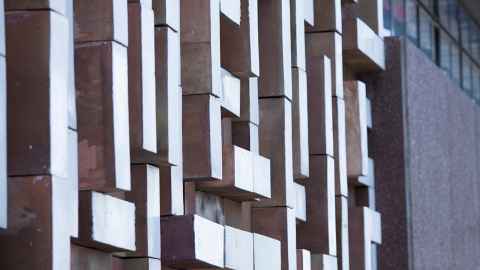Analysis, geometry and topology research
The research areas of analysis, geometry and topology have strengths in differential geometry, functional analysis, harmonic analysis and topology.

Research topics
Applications of topology to analysis
In this research topic, we apply general topology to problems in analysis and functional analysis. These two areas played fundamental roles in the birth of general topology.
At the interface of these two disciplines are several interesting concepts and results.
Conformal geometry, submanifolds, and natural partial differential equations
Natural partial differential equations (PDE) are equations whose coefficients are geometrically determined by the underlying structure on which they are defined.
They provide the primary tool for studying global structures via analysis and a vast array of physical and natural phenomena from particle equations to biological systems.
Degenerate operators
The heat flow is well understood when the conductivity is positive (but not necessarily smooth), and when the conductivity is smooth but vanishes at some parts of the material.
We aim to understand the global behaviour of heat flow if the conductivity is both non-smooth and may vanish on some parts.
Generalised inverse limits
Mathematicians have studied inverse limits extensively for many years. However, the introduction of generalised inverse limits (GILS) is relatively recent. They involve subsets of infinite dimensional spaces, working backwards through (bonding) functions to find their coordinates.
Our research studies the relationship between the properties of inverse limits and the properties of their bonding functions.
Noncommutative function theory and (real) algebraic geometry
Noncommutative function theory investigates functions in several matrix or operator variables, in a dimension-independent way. Typical examples are nc polynomials and nc rational functions, whose zero and positivity sets are the focal point of noncommutative (real) algebraic geometry. Both areas leverage a fusion of analysis and algebra to tackle problems from various sources, such as operator spaces, free probability, control systems, and quantum information theory.
Pluripotential theory
We study potential theory on general spaces in several complex variables.
Our research replaces the complex plane by more general spaces. In particular, algebraic varieties, which are geometric sets given by solutions to polynomial equations.
Semiclassical and harmonic analysis
Harmonic analysis is the study of functions by decomposition into simple component pieces. A good example of this type of analysis is the Fourier transform, where functions are represented as sums (or integrals) of sinusoidal waves. Semiclassical analysis refers to the analysis of parameter dependent problems. The initial application was to the quantum-classical limit (and this is what gave rise to the name).
Both fields yield applications across a wide range of areas, often connected with the solutions to partial differential equations.
Tight frames and their symmetries
If one of two cartesian coordinates for a battleship is lost, then its position can no longer be determined. However, it is possible to give three coordinates so that its position can still be determined if one is lost (this is more efficient than repeating both coordinates twice). This is an example of what is called a tight frame.
Tight frames offer natural generalisations of orthonormal bases which reflect additional symmetries of the space.
Moduli Spaces and Geometric Invariants
Moduli spaces are spaces whose points represent geometric objects of some fixed kind, or equivalence classes of such objects. Examples include the moduli space of solutions to partial differential equations that originate in theoretical physics, such as the instanton and the Seiberg-Witten equations. A moduli space often has a rich geometry, and it can be used to define invariants of other mathematical structures, such as knots and low-dimensional manifolds. The study of moduli spaces and their associated invariants is a deep and rewarding subject, involving several branches of mathematics.
Noncommutative function theory and (real) algebraic geometry
Noncommutative function theory investigates functions in several matrix or operator variables, in a dimension-independent way. Typical examples are nc polynomials and nc rational functions, whose zero and positivity sets are the focal point of noncommutative (real) algebraic geometry. Both areas leverage a fusion of analysis and algebra to tackle problems from various sources, such as operator spaces, free probability, control systems, and quantum information theory.
Our researchers
Dr Pedram Hekmati
- Differential geometry
- Lie theory
- Mathematical physics
Professor Rod Gover
- Differential geometry
- Analysis on manifolds
- Partial differential equations and mathematical physics
- Conformal and related structures
Associate Professor Sina Greenwood
- Continua theory
- Discrete dynamical systems
Dr Sione Ma'u
- Pluripotential theory and its applications
- Functions of several complex variables
Dr Melissa Tacy
- Harmonic analysis
- Semiclassical analysis
- Partial differential equations
Professor Tom ter Elst
- Harmonic analysis
- Operator theory
- Geometric analysis
- Sub-elliptic and degenerate operators
- Partial differential equations
Dr Jurij Volčič
- Real algebraic geometry
- Noncommutative function theory
- Representation theory
- Operator algebras
Associate Professor Shayne Waldron
- Finite tight frames with symmetries
- Approximation theory
- Polynomial interpolation
- Numerical methods
Notable visitors
The Department of Mathematics hosts many international visitors, some of our notable visitors in the field of analysis, geometry and topology include:
- Professor Mina Aganagic (University of California, Berkeley)
- Professor Wolfgang Arendt (University of Ulm)
- Professor Len Bos (University of Verona)
- Professor Andreas Cap (University of Vienna)
- Professor Michael Freedman (Microsoft Station Q)
- Professor Stavros Garoufalidis (Georgia Institute of Technology)
- Professor Paul Gartside (University of Pittsburgh)
- Professor Judy Kennedy (Lamar University)
- Professor Zengjian Lou (Shantou University)
- Professor Clifford Taubes (Harvard University)
- Professor Ed Witten (IAS, Princeton)
- Professor Richard Melrose (Massachusetts Institute of Technology)